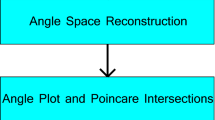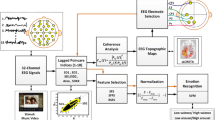Abstract
Recently, the recognition of emotions with electroencephalographic (EEG) signals has received increasing attention. Furthermore, the nonstationarity of brain has intensified the application of nonlinear methods. Nonetheless, metrics like quadratic sample entropy (QSE), amplitude-aware permutation entropy (AAPE) and permutation min-entropy (PME) have never been applied to discern between more than two emotions. Therefore, this study computes for the first time QSE, AAPE and PME for recognition of four groups of emotions. After preprocessing the EEG recordings, the three entropy metrics were computed. Then, a tenfold classification approach based on a sequential forward selection scheme and a support vector machine classifier was implemented. This procedure was applied in a multi-class scheme including the four groups of study simultaneously, and in a binary-class approach for discerning emotions two by two, regarding their levels of arousal and valence. For both schemes, QSE+AAPE and QSE+PME were combined. In both multi-class and binary-class schemes, the best results were obtained in frontal and parietal brain areas. Furthermore, in most of the cases channels from QSE and AAPE/PME were selected in the classification models, thus highlighting the complementarity between those different types of entropy indices and achieving global accuracy results higher than 90% in multi-class and binary-class schemes. The combination of regularity- and predictability-based entropy indices denoted a high degree of complementarity between those nonlinear methods. Finally, the relevance of frontal and parietal areas for recognition of emotions has revealed the essential role of those brain regions in emotional processes.






Similar content being viewed by others
References
Abásolo D, Hornero R, Gómez C, García M, López M. Analysis of EEG background activity in Alzheimer’s disease patients with Lempel-Ziv complexity and central tendency measure. Med Eng Phys. 2006;28(4):315–22.
Alia-Klein N, Preston-Campbell RN, Moeller SJ, Parvaz MA, Bachi K, Gan G, et al. Trait anger modulates neural activity in the fronto-parietal attention network. PloS one. 2018;13:(4).
Azami H, Escudero J. Amplitude-aware permutation entropy: Illustration in spike detection and signal segmentation. Comput Meth Prog Bio. 2016;128:40–51.
Bagherzadeh S, Maghooli K, Farhadi J, Soroush MZ. Emotion recognition from physiological signals using parallel stacked autoencoders. Neurophysiology. 2018;50(6):428–35.
Bandt C, Pompe B. Permutation entropy: A natural complexity measure for time series. Phys Rev Lett. 2002;17:174102.
Bonaccorso G. Machine learning algorithms. Packt Publishing Ltd. 2017.
Cai J, Chen W, Yin Z. Multiple transferable recursive feature elimination technique for emotion recognition based on EEG signals. Symmetry. 2019;11(5):683.
Cao Y, Cai L, Wang J, Wang R, Yu H, Cao Y, et al. Characterization of complexity in the electroencephalograph activity of Alzheimer’s disease based on fuzzy ntropy. Chaos. 2015;25(8):083116.
Dasdemir Y, Yildirim E, Yildirim S. Analysis of functional brain connections for positive-negative emotions using phase locking value. Cogn Neurodynamics. 2017;11(6):487–500.
Davidson RJ. Affect, cognition, and hemispheric specialization. In: Emotion, Cognition, and Behavior. Cambridge University Press. New York. 1988;320–365.
Delorme A, Makeig S. EEGLAB: An open source toolbox for analysis of single-trial EEG dynamics including independent component analysis. J Neurosci Methods. 2004;134(1):9–21.
Dzedzickis A, Kaklauskas A, Bucinskas V. Human emotion recognition: Review of sensors and methods. Sensors. 2020;20(3):592.
Egger M, Ley M, Hanke S. Emotion recognition from physiological signal analysis: A review. Electronic Notes in Theoretical Computer Science. 2019;343:35–55.
Gao Z, Cui X, Wan W, Gu Z. Recognition of emotional states using multiscale information analysis of high frequency EEG oscillations. Entropy. 2019;21(6):609.
García-Martínez B, Martínez-Rodrigo A, Fernández-Caballero A, Moncho-Bogani J, Alcaraz R. Nonlinear predictability analysis of brain dynamics for automatic recognition of negative stress. Neural Comput Appl. 2018;1–11.
García-Martínez B, Martínez-Rodrigo A, Zangróniz R, Pastor JM, Alcaraz R. Symbolic analysis of brain dynamics detects negative stress. Entropy. 2017;19(5):196.
Han J, Zhang Z, Schuller B. Adversarial training in affective computing and sentiment analysis: Recent advances and perspectives. IEEE Comput Intell Mag. 2019;14(2):68–81.
Hatamikia S, Nasrabadi AM. Recognition of emotional states induced by music videos based on nonlinear feature extraction and SOM classiffication. In: 21th Iranian Conference on Biomedical Engineering (ICBME). IEEE. 2014;333–337.
Hou Y, Chen S. Distinguishing different emotions evoked by music via electroencephalographic signals. Comput Intel Neurosc. 2019;2:1–18.
Huang H, Xie Q, Pan J, He Y, Wen Z, Yu R, et al. An EEG-based brain computer interface for emotion recognition and its application in patients with disorder of consciousness. IEEE Trans Affect Comput. 2019.
Ieracitano C, Mammone N, Hussain A, Morabito FC. A novel multi-modal machine learning based approach for automatic classiffication of EEG recordings in dementia. Neural Networks. 2020;123:176–90.
Ismail WW, Hanif M, Mohamed S, Hamzah N, Rizman ZI. Human emotion detection via brain waves study by using electroencephalogram (EEG). International Journal on Advanced Science Engineering and Information Technology. 2016;6(6):1005–111.
Jin Z, Zhou G, Gao D, Zhang Y. EEG classiffication using sparse Bayesian extreme learning machine for brain-computer interface. Neural Comput Appl. 2018;1–9:
Jung Y, Hu J. A K-fold averaging cross-validation procedure. Journal of Nonparametric Statistics. 2015;27(2):167–79.
Kang J, Chen H, Li X, Li X. EEG entropy analysis in autistic children. Journal of Clinical Neuroscience. 2019;62:199–206.
Kaya D. The mRMR-CNN based inffluential support decision system approach to classify EEG signals. Measurement. 2020;156:107602.
Keller K, Unakafov A, Unakafova V. Ordinal patterns, entropy, and EEG. Entropy. 2014;16(12):6212–39.
Kim MK, Kim M, Oh E, Kim SP. A review on the computational methods for emotional state estimation from the human EEG. Comput Math Method M. 2013;573734. https://doi.org/10.1155/2013/573734
Klem GH, Lüders HO, Jasper HH, Elger C. The ten-twenty electrode system of the International Federation. Electroencephalography and Clinical Neurophysiology. 199;52:3–6.
Koelstra S, Muhl C, Soleymani M, Lee JS, Yazdani A, Ebrahimi T, Pun T, Nijholt A, Patras I. DEAP: A database for emotion analysis using physiological signals. IEEE Transactions on Affective Computing. 2012;3(1):18–311.
Kuppens P, Tuerlinckx F, Russell JA, Barrett LF. The relation between valence and arousal in subjective experience. Psychological Bulletin. 2013;139(4):917–40.
Lake DE, Moorman JR. Accurate estimation of entropy in very short physiological time series: The problem of atrial brillation detection in implanted ventricular devices. American Journal of Physiology-Heart and Circulatory Physiology. 2011;300(1):H319–H325325.
Martínez-Rodrigo A, García-Martínez B, Alcaraz R, González P, Fernández- Caballero A. Multiscale entropy analysis for recognition of visually elicited negative stress from EEG recordings. Int J Neural Sys. 2019;29(02):1850038.
Martínez-Rodrigo A, García-Martínez B, Zunino L, Alcaraz R, Fernández-Caballero A. Multi-lag analysis of symbolic entropies on EEG recordings for distress recognition. Frontiers in Neuroinformatics. 2019;13:40.
Nauta WJ. Neural associations of the frontal cortex. Acta Neurobiologiae Experimentalis. 1972;32(2):125–40.
Pedroni A, Bahreini A, Langer N. Automagic: Standardized preprocessing of big EEG data. Neuroimage. 2019;200:460–73.
Poria S, Cambria E, Bajpai R, Hussain A. A review of affective computing: From unimodal analysis to multimodal fusion. Information Fusion. 2017;37:98–125.
Portnova G, Maslennikova A, Varlamov A. Same music, different emotions: Assessing emotions and EEG correlates of music perception in children with ASD and typically developing peers. Advances in Autism. 2018;4(3):85–94.
Richman JS, Moorman JR. Physiological time-series analysis using approximate entropy and sample entropy. American Journal of Physiology-Heart and Circulatory Physiology. 2000;78(6):H2039–H20492049.
Rubia K. The neurobiology of meditation and its clinical effectiveness in psychiatric disorders. Biological Psychology. 2009;82(1):1–11.
Russell JA. A circumplex model of affect. J Pers Soc Psychol. 1980;39(6):1161–78.
Saarimäki H, Gotsopoulos A, Jääskeläinen IP, Lampinen J, Vuilleumier P, Hari R, Sams M, Nummenmaa L. Discrete neural signatures of basic emotions. Cerebral cortex. 2016;26(6):2563–73.
Soroush MZ, Maghooli K, Setarehdan SK, Nasrabadi AM. Emotion recognition through EEG phase space dynamics and Dempster-Shafer theory. Medical Hypotheses. 2019;127:34–45.
Sun L, Feng Z, Lu N, Wang B, Zhang W. An advanced bispectrum features for EEG-based motor imagery classiffication. Expert Syst Appl. 2019;131:9–19.
Vijayan AE, Sen D, Sudheer AP. EEG-based emotion recognition using statistical measures and auto-regressive modeling. Int Conf Comput Intell Comm Tech. 2015;587–91.
Wagh KP, Vasanth K. Electroencephalograph (EEG) based emotion recognition system: A review. In: Innovations in Electronics and Communication Engineering. Springer. 2019;37–59.
Zhang Q, Hu Y, Potter T, Li R, Quach M, Zhang Y. Establishing functional brain networks using a nonlinear partial directed coherence method to predict epileptic seizures. J Neurosci Methods. 2020;329:108447.
Zhang Y, Ji X, Zhang S. An approach to EEG-based emotion recognition using combined feature extraction method. Neuroscience Letters. 2016;633:152–7.
Zhang Y, Wang Y, Jin J, Wang X. Sparse Bayesian learning for obtaining sparsity of EEG frequency bands based feature vectors in motor imagery classiffication. Int J Neural Syst. 2017;27(02):1650032.
Zhang Y, Zhou G, Jin J, Zhao Q, Wang X, Cichocki A. Sparse Bayesian classiffication of EEG for brain-computer interface. IEEE Trans Neural Netw Learn Syst. 2015;27(11):2256–67.
Zhao X, Shang P, Huang J. Permutation complexity and dependence measures of time series. Europhysics Letters. 2013;102(4):40005.
Zunino L, Olivares F, Rosso OA. Permutation min-entropy: An improved quantifier for unveiling subtle temporal correlations. Europhysics Letters. 2015;109(1):10005.
Acknowledgements
This work was partially supported by Spanish Ministerio de Ciencia, Innovación y Universidades, Agencia Estatal de Investigación (AEI) / European Regional Development Fund (FEDER, UE) under DPI2016-440 80894-R, PID2019-106084RB-I00 and 2018/11744 grants, by Castilla-La Mancha Regional Government / FEDER, UE under SBPLY/17/180501/000192 grant, and by Biomedical Research Networking Centre in Mental Health (CIBERSAM) of the Instituto de Salud Carlos III. Beatriz García-Martínez holds FPU16/03740 scholarship from Spanish Ministerio de Educación y Formación Profesional. Luciano Zunino acknowledges the financial support from Consejo Nacional de Investigaciones Científicas y Técnicas (CONICET), Argentina.
Author information
Authors and Affiliations
Corresponding author
Ethics declarations
Conflicts of Interest
Authors declare that they have no conflict of interests.
Ethical Approval
This article does not contain any studies with human participants or animals performed by any of the authors.
Rights and permissions
About this article
Cite this article
García-Martínez, B., Fernández-Caballero, A., Zunino, L. et al. Recognition of Emotional States from EEG Signals with Nonlinear Regularity- and Predictability-Based Entropy Metrics. Cogn Comput 13, 403–417 (2021). https://doi.org/10.1007/s12559-020-09789-3
Received:
Accepted:
Published:
Issue Date:
DOI: https://doi.org/10.1007/s12559-020-09789-3




